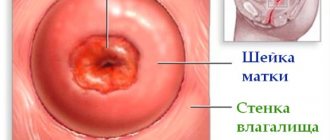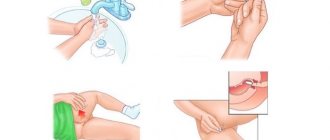Cauterization of erosion often goes away without any side effects. However, many gynecological procedures affect the course of menstruation. Menstruation after cauterization of cervical erosion may change slightly. Often such a violation does not pose any danger. The amount of discharge or the timing of your period often changes. Menstruation is restored after some time and becomes the same as before. Cauterization is a kind of injury to the mucous membrane. At first, the resulting injuries may bleed. Such discharge differs from critical days in volume and color.
Cervical erosion must be treated
What is erosion?
Cervical erosion is a frequently diagnosed gynecological pathology in women. Due to the limited amount of information, many women perceive this diagnosis as a death sentence, equating it, if not with a cancerous tumor, then at least with a harbinger of such a malignant process. At the same time, experts do not classify many types of erosions as diseases, excluding them from international medical reference books.
It is important to understand that after cauterization of erosion, menstruation occurs differently for everyone.
Cervical erosion is any violation of the normal physiological state of its mucous membranes. Such disorders include mechanical and chemical damage, abnormal development of the epithelium. According to the nature and causes of erosion, they are divided into two main types:
- true erosion;
- pseudoerosion or ectopia.
Menstruation during erosion: differences
Pathological changes in the epithelial layer of the cervix do not appear in any way for some time. Erosion is noticeable during a gynecological examination, but not all women undergo it with due regularity. And yet there are features that, with careful attention, you can notice on your own. Menstruation becomes a little different with erosion. In most cases, they are preceded by a brownish daub 2-3 days before the critical ones. This may also indicate that the inflammation has affected other internal genital organs. Discharge before menstruation is also due to the fact that erosion before menstruation seems to swell and also begins to separate cells.
Premenstrual spotting almost always occurs in women who are sexually active. Blood also comes out between periods. After sexual intercourse or some time later, small amounts of reddish or brownish discharge are noticed.
Otherwise, with erosion, menstruation occurs as usual. But if the disease is more than one year old, its inherent hormonal imbalance can affect the abundance of menstruation. The discharge may become noticeably more or, conversely, less than in full health.
When you wait a long time to get your period
It is not uncommon for menstruation to be delayed due to erosion. This happens if it is large and present long enough. The appearance of the disease is often caused by hormonal imbalances. Erosion that occurs for other reasons may itself provoke a failure in this area. And the first manifestation of hormonal disorders is problems with the length of the cycle. Delayed menstruation due to cervical erosion can be repeated in each of them and interspersed with discharge between menstruation. The disease can add pain to sensations on critical days.
If a woman is diagnosed with cervical erosion and has not had periods for a long time, it is worth taking a pregnancy test. The disease does not exclude conception, but you will have to get rid of the disease some time after birth.
Classification
In addition, the classification of erosions can clarify their features:
- ectropion - displacement of the internal cervical tissue forward and outward due to strong mechanical pressure, usually occurring during difficult childbirth or late-term abortions;
- endometriosis - vertical displacement and overlap of different types of tissue of the mucous membrane of the cervix;
- leukoplakia - hardening and ossification of multilayer epithelium in any area of the mucosa.
Polyps of the cervical canal and viral condylomas are considered a separate category of erosions.
What should be the normal monthly period after cauterization of erosion?
Indications for the procedure
Doctors recommend cauterization of erosion with electric current for women who no longer intend to become pregnant in the following cases:
- as a result of erosion, deformation of the cervical region occurred;
- extensive area of ecropion;
- erosion is complicated by cysts;
- erosion is combined with endometriosis;
- a precancerous change in the cells of the cervix or cervical canal has been diagnosed.
When to do cauterization and when not to do it, read here.
How does the menstrual cycle change after moxibustion?
The reason for the formation of cervical erosion is considered to be some degeneration and damage to squamous epithelial cells in this area. In place of healthy tissues, cylindrical cells are formed. In modern gynecological practice, several methods are used to eliminate this pathological process:
- traditional, that is, using medications for local use (ointments, suppositories and vaginal tablets);
- chemical - through the use of "Solkovagina";
- exposure to liquid nitrogen;
- radio wave therapy;
- electric current treatment;
- laser surgery.
Menstruation after cauterization of cervical erosion should normally begin on time or with minor deviations relative to the timing. The menstrual cycle may be disrupted for reasons that are not related to the treatment of this pathology.
If menstruation began much earlier or later, became more abundant or, conversely, scanty, one may suspect the occurrence of a hormonal imbalance and the development of other pathologies of the reproductive system.
Delayed menstruation
Delayed menstruation after cauterization of erosion is not any complication and can occur for three main reasons:
- exposure to temperature caused damage to uterine receptors;
- gynecological manipulations led to trauma to the mucous membrane;
- psychological factor - during the procedures and treatment, the woman could experience stress, which resulted in a delay in menstruation.
Despite the safety of this type of therapeutic procedure, a woman experiences excessive anxiety from the need for surgical intervention, and stress can cause cycle disturbances. A common question women ask their gynecologist is whether menstruation may not come on time after cauterization of erosion? The delay is often accompanied by nagging pain. This condition may persist for several days. If menstruation does not occur for more than 10 days, you must visit a gynecologist to rule out pregnancy or use special tests.
Another factor that can provoke a long absence of menstrual periods is cervical stenosis. Such a complication occurs, as a rule, due to prolonged temperature effects on individual parts of the organ. Narrowing of the cervical lumen can lead to accumulation of blood in the uterine cavity, followed by an inflammatory process in it. To eliminate such a pathological process, surgical techniques are used.
What if, after cauterization of the erosion, menstruation began earlier?
Stages
The intervention is carried out in three stages. They cannot be neglected. This includes preparation, the actual manipulation and the recovery period. The success of the intervention depends on the thoroughness of their implementation.
Preparation
Cauterization of erosion with argon requires the same preparation as any other type of coagulation. It is necessary that the intervention be carried out on days 5-7 of the cycle, because this way healing will occur faster. Before performing the manipulation, you need to make sure that there is no inflammation, fungi, or viruses. To do this, a number of analyzes are carried out:
- Smear;
- Cytology;
- Biopsy;
- Analysis for sexually transmitted infections;
- Colposcopic examination.
Proper and comprehensive preparation is necessary to determine the scope of intervention. And also in order to promptly identify contraindications to intervention in the patient. In addition, the need to promptly diagnose and treat inflammation, the presence of which can lead to a risk of infection during coagulation, plays a significant role.
Soreness
The procedure is completely painless. There is no direct contact of the epithelium with the equipment, therefore the discomfort during the intervention is minimal. Moreover, there are very few nerve endings in the cervix. But at the patient’s request, the doctor can administer local anesthesia, which is applied externally.
Scab (white area)
Duration
The duration of the intervention depends on the size of the erosion. In some cases, one sensor installation is sufficient, in others – several. Treatment of one zone to which the waves are directed takes 7-12 minutes. Together with installing the colposcope, setting up the equipment, etc., the entire procedure takes from 20 minutes to half an hour.
Technique
The intervention is carried out as follows:
- The patient is located in a gynecological chair;
- A neutral electrode is placed under her buttocks;
- An extended colposcopy is performed;
- The sensor is inserted into the vagina so that its working surface is half a centimeter away from the affected area;
- Using pedals, the doctor activates the device, setting the desired treatment depth;
- A torch of argon plasma appears;
- After the required time of exposure to the area, the torch coagulates it, and the area acquires a sandy tint.
After this, the patient receives the necessary recommendations and can go home.
Recovery period
The recovery period after such an intervention is much shorter than with other types of coagulation. It is only about a month. However, there are some restrictions that must be followed during this period:
- You cannot be sexually active for about 4-5 weeks, and then for six months after the intervention it is better to use barrier contraception methods;
- You cannot swim or take baths, that is, completely immerse your body in water, only a shower is allowed;
- You cannot overheat in a sauna, sauna, solarium, on the beach, etc.;
- After 1-2 months after the procedure, it is recommended to do a repeat colposcopy to monitor the healing process;
- In extremely rare cases, a repeat procedure is required.
Complete recovery and epithelization occur after 45 days.
Early onset of menstruation
Cauterization of erosion does not affect the onset of menstruation in any way. As a rule, the first menstruation after treatment should begin after about 3-4 weeks, depending on the natural length of the period. Within a week, bloody streaks may be observed in the vaginal discharge, which should not be confused with menstruation.
With large erosions, pinkish discharge may also be observed. Approximately on the tenth day after the procedure, the postoperative scab should come off, which is accompanied by the appearance of secretion, which can be confused with the premature onset of menstruation. At the same time, women think that their periods began a little earlier, and if the process of scab removal and cervical healing is disrupted, this can cause heavy bleeding. In cases of significant deviations from the normal cycle, consultation with a gynecologist is necessary.
The second period may also occur after cauterization of the erosion.
Progress and duration of the operation
The procedure consists of the following steps:
- the walls of the vagina and the outer part of the cervix are treated with an antiseptic;
- local anesthesia is administered;
- then the erosion is cauterized;
- the doctor evaluates the manipulation performed.
NOTE!
As mentioned above, one of the disadvantages of cauterizing erosion with electric current is pain. Therefore, the procedure is performed under anesthesia.
An unpleasant feature of the procedure is also the smell of burnt meat, which is always present when electric current is used for surgical purposes.
It is very important to stop bleeding after diathermocoagulation. Therefore, the doctor must examine the cauterization site very carefully. The surface cut off during the procedure is sent to histology. The whole procedure takes no more than 20 minutes.
Scanty or heavy discharge
A change in the nature of the discharge may be due to the fact that before therapy for cervical erosion, menstruation could occur with some disturbances. Restoration of mucous tissue leads to normalization of the menstrual cycle. If after treatment the patient experiences watery, heavy menstruation with the presence of isolated blood clots, this may indicate a protracted process of stabilizing the condition of the genital organs. Excessive discharge may occur in the first two to three cycles. If after this time the appearance of menstrual flow does not change, it is necessary to undergo a diagnostic examination.
The onset of scanty and spotting discharge may be associated with hormonal imbalance. If scanty menstruation is combined with nagging pain in the lumbar region and lower abdomen, this may indicate the occurrence of spastic phenomena.
Possible complications
The complication rate is relatively low. Menstruation after cauterization of erosion is an indirect indicator of the normal process of restoration of cervical tissue. If menstruation is accompanied by severe pain or specific secretion, you should consult a doctor. In some cases, the following pathological conditions may occur:
- Cervical stenosis. A slight degree of such narrowing does not affect the quality of life of patients who are not planning a pregnancy. For nulliparous women, this can cause infertility.
- Penetration of endometrial cells into the surface of the wound, which leads to the development of a pathology such as endometriosis. The initial symptoms of this may be heavy bleeding, painful periods.
- Infection of the scab, which occurs as a result of violations of the rules of treatment or hygiene during the recovery period. This condition manifests itself as painful and thick discharge of blood from the genital tract.
Similar complications can arise after any method of cauterization of erosion, including the most harmless - radio wave. Untreated pathology poses an even greater health hazard than rare cases of problems developing in the postoperative period.
Now it has become known why, after cauterization of erosion, menstruation begins earlier or later.
Preventive methods
To avoid menstrual irregularities after erosion therapy, it is necessary to strictly follow the doctor’s recommendations during the rehabilitation process. A woman should avoid procedures that may lead to increased blood circulation in the reproductive organs. Patients are prohibited from:
- visit baths and saunas, refrain from other warming influences on the lower body;
- drink alcoholic beverages;
- play sports, lift weights, and expose yourself to other types of physical activity that can cause bleeding;
- massage on the lumbar region;
- treatment with leeches;
- swim in open water and visit the pool;
- to take a bath;
- undergo physical procedures that affect the lower abdomen.









